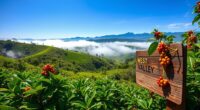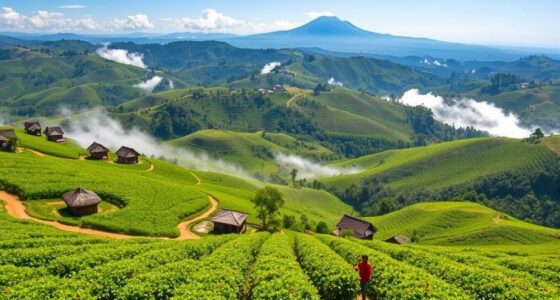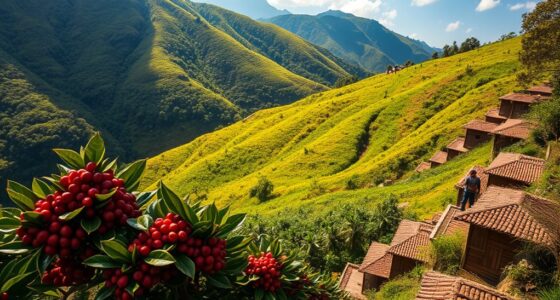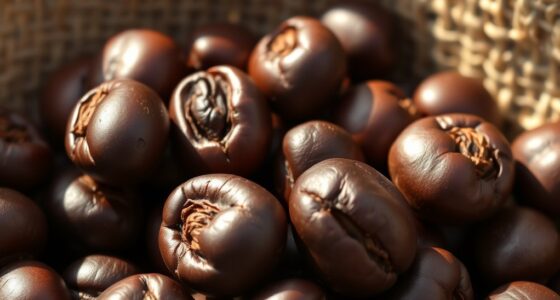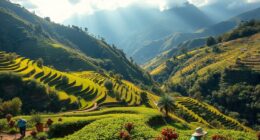Discover Panama’s rich coffee heritage, especially in Boquete and Geisha varieties. In Boquete, high-altitude farms with volcanic soil produce some of the world’s finest, eco-friendly beans, emphasizing quality and sustainability. The iconic Geisha coffee, originally from Ethiopia, thrives here with its floral aroma, bright acidity, and complex flavors. This guide offers insights into Panama’s unique cultivation techniques and eco-conscious practices—exploring more reveals how tradition and innovation come together in every cup.
Key Takeaways
- Boquete’s highlands produce award-winning, shade-grown single origin coffee with rich, complex flavors and eco-friendly farming practices.
- Panama’s Geisha coffee is renowned for its floral aroma, bright acidity, and unique tasting notes like jasmine and mango.
- Sustainable cultivation methods in Panama prioritize environmental health, biodiversity, and support local communities.
- The region’s volcanic soil and favorable climate create ideal conditions for high-quality coffee production.
- Panama’s coffee heritage embodies tradition, innovation, and environmental responsibility, offering a rich experience for enthusiasts.
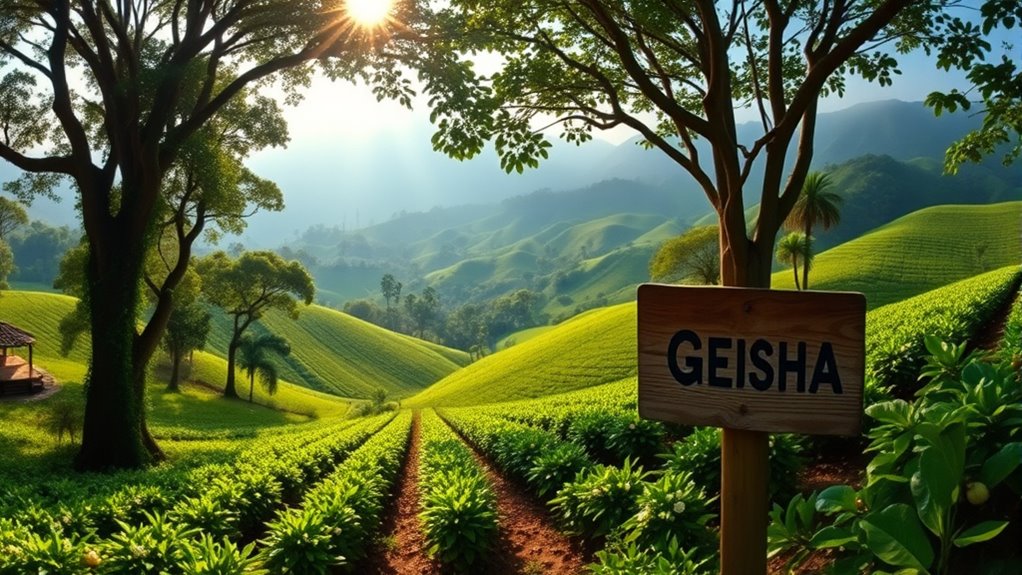
If you’re a coffee enthusiast, Panama should be on your radar. This country is renowned for its exceptional coffee, especially its single origin beans that showcase the unique flavors of the region. When you visit Panama, you’re not just tasting coffee — you’re experiencing a story of sustainable farming practices that have been passed down through generations. The country’s rich volcanic soil and favorable climate create ideal conditions for growing high-quality beans, and many farmers prioritize eco-friendly methods that conserve the land for future harvests. These sustainable practices guarantee that every cup you enjoy supports local communities and promotes environmental health, making your coffee experience both delicious and responsible.
Panama’s coffee tells a story of sustainable practices, rich flavors, and respect for the land.
In particular, the Boquete region stands out as a coffee lover’s paradise. Nestled in the highlands, Boquete’s cool temperatures and fertile volcanic soil produce some of the finest single origin beans in the world. The farms here often operate on small scales, emphasizing quality over quantity. By focusing on sustainable farming, farmers conserve water, reduce chemical use, and implement shade-grown techniques that protect local biodiversity. This attention to eco-conscious methods results in beans that are not only vibrant and complex in flavor but also ethically produced. When you sip coffee from Boquete, you’re tasting the dedication and environmental mindfulness woven into every harvest.
Panama’s reputation for the legendary Geisha coffee is built on the same principles. These beans, originally discovered in Ethiopia, have found a perfect home in Panama’s high-altitude regions. The Geisha variety is prized for its floral aroma, bright acidity, and layered taste profile that can include hints of jasmine, mango, and bergamot. Growers here often rely on meticulous, sustainable farming techniques to nurture these delicate beans, ensuring they develop their characteristic flavors without compromising the environment. The rarity and quality of Panama’s Geisha create a sense of exclusivity, but what truly sets it apart is the care and respect for nature embedded in its cultivation.
As a coffee lover, you’ll notice that Panama’s commitment to sustainable farming and high-quality single origin beans makes every cup a reflection of the country’s rich heritage and environmental responsibility. Whether you’re savoring a cup of Boquete’s robust coffee or the aromatic Geisha, you’re tasting more than just caffeine — you’re experiencing a story of tradition, innovation, and respect for the land. Panama’s coffee scene invites you to appreciate the artistry behind each brew and to support practices that promote a sustainable future for this vibrant industry.
Frequently Asked Questions
How Do I Identify Authentic Geisha Coffee?
To identify authentic Geisha coffee, look for proper coffee certification that verifies its origin and quality. Use tasting techniques like noting floral, fruity, and tea-like flavors, which are characteristic of genuine Geisha beans. Trust reputable sellers and ask for detailed information about the farm and processing methods. Authentic Geisha will have a complex aroma and a smooth, balanced acidity, confirming its premium status.
What Is the Best Time to Visit Boquete for Coffee Tours?
You’ll want to visit Boquete during the dry season, from January to April, when clear skies and lush coffee plantations create an ideal backdrop—like a perfectly brewed cup. The best visiting seasons for coffee tours are during these months, offering peak tour timing. I once watched a sunrise over terraced coffee farms, and that peaceful moment made me realize this is the perfect time to explore.
Are There Sustainable Coffee Farms in the Region?
Yes, you can find sustainable coffee farms in the region that prioritize eco-friendly practices and sustainable farming methods. These farms focus on conserving water, reducing chemical use, and supporting local ecosystems. When you visit, you’ll see how they implement environmentally responsible techniques, ensuring the area’s natural beauty and coffee quality are preserved for future generations. Supporting these farms helps promote sustainable development in the region.
How Does Altitude Affect Coffee Flavor in Panama?
Imagine climbing a mountain where the air thins—altitude influence becomes your secret ingredient. Higher elevations in Panama slow coffee cherry ripening, allowing complex flavor development. You’ll notice brighter, more nuanced notes, with vibrant acidity and floral undertones. As you sip, it’s like tasting the mountain’s essence—where altitude shapes the coffee’s character, transforming each cup into a rich, layered experience born from the sky’s elevation.
Can I Participate in Coffee Harvesting Activities?
Yes, you can participate in coffee harvesting activities. Many plantations welcome visitors to experience coffee picking firsthand, giving you a chance to learn about the process and enjoy the fresh air. During harvest season, you’ll join locals in picking ripe cherries, gaining a deeper appreciation for the craft. Just check with the plantation beforehand to schedule your harvest participation and guarantee you follow their guidelines for a memorable, hands-on experience.
Conclusion
As you sip your next cup of Panama coffee, remember it’s more than just a brew—it’s a journey through lush mountains and centuries of heritage. Like the delicate Geisha beans that flourish in Boquete’s rich soil, great coffee requires patience and care. Just as a master gardener tends to each plant, you can savor every sip, appreciating the artistry woven into every bean. Ultimately, Panama’s coffee invites you to slow down and truly taste the story behind each cup.

